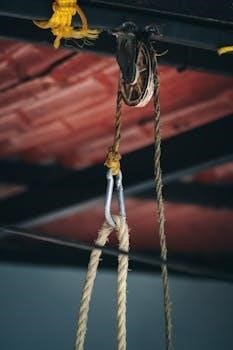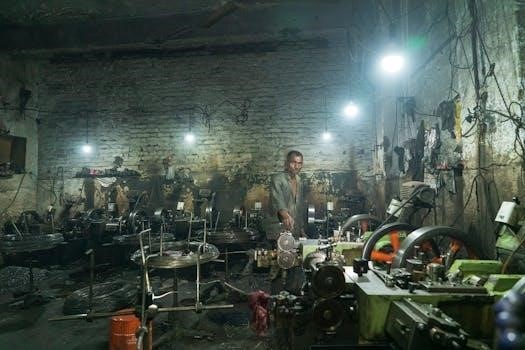Porter Cable 150 PSI Compressor Manual Overview
This manual serves as a comprehensive guide for Porter-Cable 150 PSI compressors, outlining safety procedures, operation, maintenance, and model-specific details. Understanding this manual ensures safe and efficient compressor use, preventing accidents and prolonging the unit’s lifespan.

Safety Precautions
Prioritize safety by carefully reviewing all warnings and instructions before operating the compressor. Always operate it in well-ventilated areas, away from combustible materials, to minimize risks. Follow all outlined precautions to ensure a safe working environment.
General Safety Warnings
Before operating the Porter-Cable air compressor, thoroughly read and understand all safety warnings and operating instructions to prevent potential hazards. Familiarize yourself with the compressor’s controls and features before each use. Always wear appropriate personal protective equipment, including eye and ear protection, to minimize the risk of injury.
Ensure the work area is well-ventilated and free from combustible materials like gasoline or solvent vapors. Never operate the compressor in damp or wet locations, as electrical shock hazards may exist. Inspect the compressor and its components before each use for any signs of damage or wear.
Replace damaged parts immediately. Keep children and unauthorized personnel away from the operating area. Never direct the air stream toward people or animals, and avoid exceeding the compressor’s maximum pressure rating. Always disconnect the compressor from the power source before performing any maintenance or repairs. Following these safety precautions will help ensure safe and reliable operation of your Porter-Cable air compressor.
Risk of Explosion or Fire
Operating an air compressor involves potential risks of explosion or fire if safety precautions are not strictly followed. It is normal for electrical contacts within the motor and pressure switch to spark during operation. To mitigate this risk, always operate the compressor in a well-ventilated area, far from combustible materials such as gasoline, solvents, or flammable vapors. Never spray flammable liquids near the compressor.
Ensure the compressor is placed on a stable, level surface to prevent tipping or accidental damage; Regularly inspect the air tank and pressure relief valve for any signs of corrosion, leaks, or damage. Never attempt to repair a damaged air tank; replace it immediately. Do not modify or tamper with the compressor’s safety devices, as this could compromise their effectiveness.
Always maintain the recommended air pressure and avoid exceeding the compressor’s maximum pressure rating. Over-pressurizing the tank can lead to rupture or explosion. Following these guidelines diligently will significantly reduce the risk of explosion or fire while operating your Porter-Cable air compressor.
Air Quality and Breathing Concerns
The air produced by an air compressor is generally not suitable for breathing, as it may contain contaminants. The air stream may include carbon monoxide, toxic vapors, or solid particles from the air tank. Breathing these contaminants can cause serious injury or death. Never use air obtained directly from the compressor to supply air for human consumption or for use with breathing apparatus.
The compressor is not equipped with the necessary filters to remove these harmful substances. If breathable air is required, use a dedicated air purification system designed for that purpose. Ensure that the work area is well-ventilated to minimize the concentration of airborne particles and vapors. When using the compressor for painting or other applications that generate fumes, wear a respirator to protect yourself from inhaling harmful substances.
Regularly drain the air tank to remove accumulated moisture and contaminants, which can further degrade air quality. By understanding and addressing these air quality concerns, you can ensure a safer working environment when using your Porter-Cable air compressor.

Operating Instructions
This section details the correct procedures for operating your Porter-Cable 150 PSI compressor. It covers initial setup, safe starting and stopping methods, and operational guidelines to ensure optimal performance and user safety.
Initial Setup and Preparation
Before operating your Porter-Cable 150 PSI compressor, proper setup is crucial for safety and optimal performance. First, carefully unpack the compressor and inspect it for any damage that may have occurred during shipping. Ensure all components are present, referring to the parts list in the manual.
Next, select a well-ventilated and clean operating area, free from combustible materials, gasoline, or solvent vapors. Position the compressor on a level surface to prevent instability and potential accidents. Check the power cord for any signs of damage and ensure it is properly grounded.
Before connecting to a power source, verify that the compressor’s voltage matches your power supply. Connect the air hose to the compressor’s outlet fitting, ensuring a secure and airtight connection. Finally, familiarize yourself with the compressor’s controls, including the pressure regulator, pressure gauge, and on/off switch. Following these initial setup steps will prepare your compressor for safe and effective operation.
Starting and Stopping the Compressor
To start your Porter-Cable 150 PSI compressor safely and effectively, first ensure the unit is properly set up as described in the “Initial Setup and Preparation” section. Verify that the air hose is securely connected and the area is clear of obstructions. Locate the on/off switch, typically found on the compressor’s control panel.
Turn the switch to the “on” position. The compressor motor will start, and the tank will begin to fill with air. Monitor the pressure gauge, and allow the compressor to run until it reaches the desired pressure, as indicated on the gauge. The compressor will automatically shut off when it reaches its maximum pressure.
To stop the compressor, simply turn the on/off switch to the “off” position. It is important to bleed the air from the tank after each use. This can be done by opening the drain valve located at the bottom of the tank. Bleeding the tank helps to remove moisture and prevent corrosion, prolonging the life of your compressor.

Maintenance
Regular maintenance is crucial for optimal performance and longevity. This section outlines essential tasks, including draining moisture, checking for leaks, and inspecting components. Consistent care prevents issues and ensures reliable operation.
Regular Maintenance Tasks
To ensure the longevity and efficient operation of your Porter-Cable 150 PSI compressor, adhering to a schedule of regular maintenance tasks is paramount. One of the most vital tasks is draining the air tank after each use. This prevents moisture buildup, which can lead to rust and corrosion, ultimately diminishing the tank’s integrity and performance.
Periodically inspect the air filter and clean or replace it as needed. A clean air filter ensures proper airflow to the pump, preventing overheating and maintaining optimal compression efficiency. Furthermore, regularly check all air hoses and fittings for leaks. Tighten any loose connections and replace damaged hoses immediately to prevent air loss and maintain consistent pressure.
Inspect the safety valve regularly to ensure it is functioning correctly. A properly functioning safety valve is crucial for preventing over-pressurization, a potentially hazardous condition. Additionally, lubricate the pump components as specified in the manual, using the recommended type of oil. Proper lubrication reduces friction and wear, extending the life of the pump.
Finally, keep the compressor clean and free of debris. A clean compressor operates more efficiently and is less susceptible to damage. By diligently performing these regular maintenance tasks, you can ensure your Porter-Cable compressor remains a reliable tool for years to come.
Troubleshooting
When encountering issues with your Porter-Cable 150 PSI compressor, a systematic troubleshooting approach can save time and prevent unnecessary repairs. A common problem is the compressor failing to start. Begin by checking the power source, ensuring the compressor is properly plugged in and the circuit breaker hasn’t tripped. If the motor hums but doesn’t start, the pressure switch might be faulty or the motor capacitor could be damaged.
Another frequent issue is air leakage. Inspect all hoses, fittings, and connections for leaks, tightening or replacing components as needed. If the leak originates from the tank, it may indicate corrosion or damage requiring professional repair. If the compressor runs continuously but doesn’t build pressure, the pump may be worn or the check valve could be malfunctioning.
Excessive noise can also be a sign of trouble. Check for loose components, such as the motor or pump mounts, and tighten them accordingly. Unusual vibrations may indicate a problem with the motor bearings or pump assembly. If the compressor overheats, ensure the air filter is clean and the cooling fan is functioning correctly.
Always consult the manual for specific troubleshooting steps related to your model. If you’re unable to resolve the issue, seek assistance from a qualified technician to avoid further damage or injury. Remember to disconnect the compressor from the power source before performing any troubleshooting or repairs.

Specific Model Information
This section details specifications and features unique to specific Porter-Cable 150 PSI compressor models. Refer to your model number to find relevant information regarding parts, diagrams, and troubleshooting specific to your compressor.
C2002 Model Details
The Porter-Cable C2002 is a popular pancake-style air compressor known for its portability and ease of use. This model is designed for various tasks, including inflating tires, operating nail guns, and other light-duty applications. The C2002 boasts a six-gallon tank, providing ample air storage for extended use.
Refer to this section for C2002-specific information, including detailed diagrams, parts lists, and troubleshooting guides. This information will assist in performing maintenance, repairs, and identifying compatible replacement parts. Always consult this section before attempting any repairs or modifications to your C2002 compressor.
Understanding the specific features and functionalities of the C2002 model is crucial for safe and efficient operation. Familiarize yourself with the air pressure settings, safety valves, and other model-specific components to ensure optimal performance and longevity. Keep this manual readily available for quick reference.
Remember to follow all safety precautions outlined in the general safety section of this manual, as well as any C2002-specific warnings or instructions. Proper maintenance and adherence to these guidelines will extend the life of your compressor.
CPFAC2600P Model Details
The Porter-Cable CPFAC2600P is a pancake compressor designed for various inflation and power tool applications. It has specific features and requirements unique to its design. This section provides detailed information about the CPFAC2600P model, including its components, specifications, and operating procedures. It’s crucial to understand these details for safe and optimal performance.
This section includes diagrams illustrating the location of specific parts, wiring schematics, and troubleshooting tips specific to the CPFAC2600P. It is also important to refer to this section for maintenance schedules and recommended replacement parts. Following the guidelines outlined here will help maintain the compressor and extend its lifespan.
Before operating the CPFAC2600P, carefully review this section to understand the specific safety precautions and procedures related to this model. Familiarize yourself with the location and function of all controls, valves, and safety devices. If you have any questions or concerns, consult a qualified technician or contact Porter-Cable customer support.
